Exhibition organised to raise money for

Sponsored by

Archive Home Page
Previous Exhibition Following Exhibition
St. Margaret's Hall, Coniston Road, Hatherley, Cheltenham, GL51 3NU
Exhibition organised to raise money for |  | Sponsored by |  |
Descriptions are based on material supplied by the layout owners
Barwick Green 7mm scale light railway. The layout started life as part of Thornbury MRC layout Severn Mill. Since being purchased it has undergone complete rewiring for DCC. The layout is operated using its own Wi-Fi network and old mobile phones are getting a new lease of life as controllers. The scene is still set near the Severn but it has moved further north and now has the Malvern Hills in the distance. This move has taken it to the fictional County of Borsetshire and for those in the know the name Barwick Green is synonymous with a certain Radio 4 continuing drama. The fortunes of the light railway are on the wane and the Director of the Company is fighting a losing battle with decreasing traffic. However, the wife of the Director insists that the locomotives must be kept in good external condition. The three Manning Wardle class K locos that take the lion's share of the traffic are occasionally supplemented by Hudswell Clarke 0-6-0 and Kerr Stewart "Victory" tanks, the later on hire from the Earl of Dudley's Pensnett Railway. Also on trial, borrowed from the Weston Clevedon and Portishead Railway, is Terrier "Portishead". It is currently being tried out on passenger services; the crews prefer the Manning Wardles for shunting. | 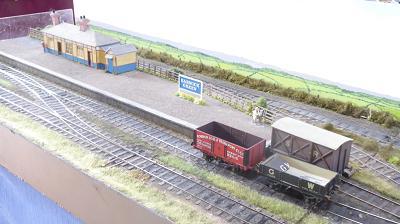 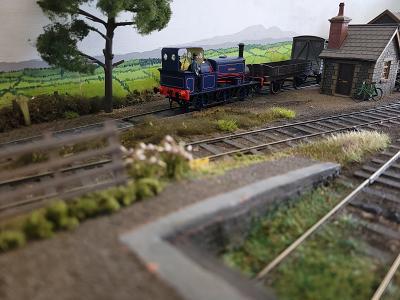 | |
 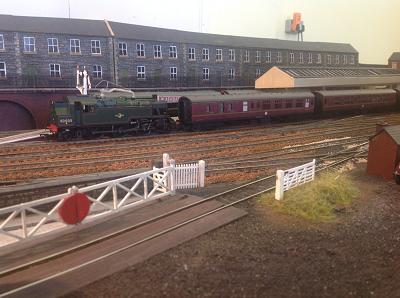 |
Blaendare Road is a fictitious small terminus in Mid Wales, North of Brecon, the layout is set in the 1950's and 1960's. The branch serves a Creamery built by the Milk Marketing Board in the late 1940's. This facility saved the branch from closure in the early years of British Railways. Goods services are provided in the yard with additional traffic generated by a Seed and Feed Merchants and a Coal Merchants yard in this mainly farming area. The station enjoys frequent passenger services from Brecon, Neath, Hereford and Newport. The track is Peco code 100 and points operated by a Seep point motors. The track is ballasted with Woodland Scenics medium ballast. All buildings are kits or modified kits. Rolling stock is mainly ready to run with a few kit built locomotives and wagons. Uncoupling ramps are mixture of Seep and homemade. | |
Bridge Street The layout is based on a OO gauge layout that was built by a small group of modellers called the Taunton Model Railway Group back in the 1970's that was called Tamrig Central. Most people will be familiar with the Bath Green Park, Somerset and Dorset layout, which normally lives in their clubrooms at Bishop Lydiard station on the West Somerset Railway. My layout so far is several years work and is still not finished yet. This is a lifelong wish from my college days when I can remember seeing the original layout at the Bristol and York shows, later in life I came to know some of the original members. Baseboards are all made of Birch plywood and Peco code 55 track work has been used throughout. The four track main line layout is analogue control but using some of the latest technical principles. Scenecraft buildings have been used to good effect for the urban back scene and many more including scratch built items. I hope you like what you see and please do ask questions. I would also like to thank my friends of the Shirehampton Model Railway Club who have contributed to the layout. | 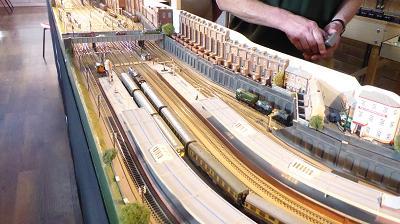 | |
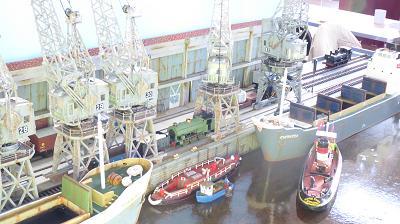 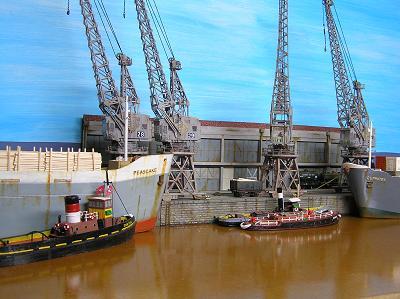 |
This layout started off as a small diorama, primarily to display two scratch built Stothert and Pitt Dockside 3 Ton electric cranes, located at MShed Museum, Bristol. However, 2020 provided an opportunity to enlarge the model by constructing a few more cranes! As a museum volunteer and operator of the four surviving cranes, I was keen to make an accurate representation. Access to the museum's archive material was really useful, as well as a working knowledge. The Stothert and Pitt electric cranes were built at Bath in 1951, working at Princes Wharf, Bristol up until the 1970's They were all sold for scrap but had a stay of execution when bought back by the newly formed Bristol Industrial Museum. Over the coming years they were restored to full working order and still lift up to their maximum weights. The model continues to evolve and construction techniques improved to such an extent, that some of the cranes actually work. People often ask if they are 3D printed.....they are not!! Each part was carefully considered and a pattern created using a range of recycled materials. Some of these materials were raided from the kitchen; including a plastic milk bottle top - for the 3 Ton crane slew ring, a marmite lid - for the 10 Ton crane (crane 32) and large rivet detail.....split lentils. With the patterns made for the 3 Ton cranes, silicon moulds were made, so that repeated copies could be made. The crane 32 model is unique, and is completely scratch built. | |
Calderbridge Calderbridge is set in Yorkshire circa 1970. The model railway is in a industrial setting with an inner city station. Diesel Multiple Units serve the passengers in this area whilst a number of freight trains pass through the station. The layout is DCC operated. | 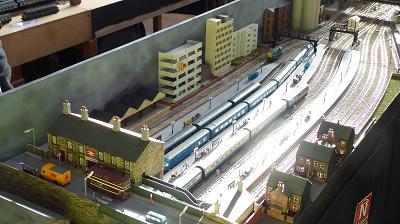 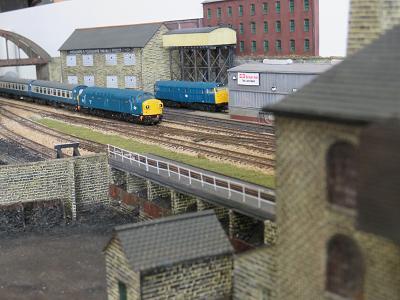 | |
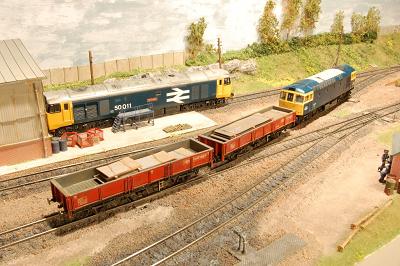  |
Orchard Road TMD is a DCC operated British Rail depot layout, based in the BR (Southern) region between 1975 and 1983 and features locomotives seen in Devon during these years. A depot has been modelled in a relatively small space, but includes a maintenance building, locomotive refuelling and fuel off-loading siding with storage tanks. The odd siding has been provided through the bridge, forming the scenic break, this represents the end of a track from the station beyond the bridge. All track is Peco 00 gauge, ballasted and then weathered to represent the track that would be seen at a diesel depot. The major structures are scratch built, but some buildings are kits. The majority of the details are kits, plastic, whitemetal and etched-brass, all have been painted and weathered. Operation is DCC, using a NCE Powercab controller, with the points also being DCC operated via an accessory decoder. The locomotives are a mixture of Bachmann, Hornby and Lima and represent those classes that would have been seen in Devon. All have been weathered and one or two are sound fitted (this will be added to over a period of time). Construction of the layout can be followed on the RMWeb layout thread web site www.rmweb.co.uk � layout thread, search for 'Orchard Road TMD'. This a vast website covering all aspects of modelling and well worth a look at. | |
Orfe Quay Orfe Quay could be considered an improvised layout, without formal planning, based on a board with a nice harbour wall and water, built by a friend. All was flattened above rail level and a fresh start made. Buildings are mostly card and Scalescenes brick paper. The intention was to avoid cliches, so no fishing boats, nets, lobster pots, sou'westers, etc. Also no short sidings, instead relying on view blockers and "endless" sidings to look as if it is part of something bigger. Stock is converted to EM by a variety of means from pulling wheels out on axles to moving finer wheels in a bit on stock already converted to P4. Uncoupling is by hand held neodymium magnets being waved under the board to uncouple anywhere without complicated delay action couplings. Ordinary couplings are fitted with magnetic tails (staples). Look up "Brian Kirby uncoupling method", though I have not seen the hand held magnet idea described elsewhere. Access to the underside of the board and strong magnets required. | 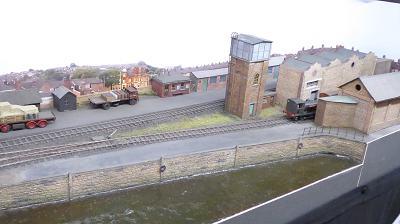 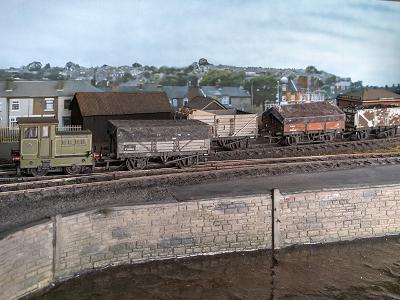 | |
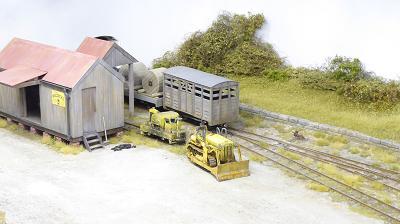  |
Set in the late 1950's to early 1960's, St Oswalds depicts a run down Welsh narrow-gauge railway goods yard in its last days before closure. The layout and its stock have a Welshpool and Llanfair flavour though also featuring locomotives and wagons from other railways. St Oswalds is built to 7mm scale and uses Peco O16.5mm gauge track. The points are operated by Tortoise point motors. The layout is designed as an inglenook shunting puzzle where the operator uses one engine to shunt a train of 8 wagons into an order determined by picking up cards from a pack. While 8 wagons may sound modest, it equates to 6720 different possible permutations. The track plan consists of two points and three sidings where the longest siding holds 5 wagons, and the other two sidings hold 3 wagons each. The head shunt allows for the engine plus 3 wagons. The stock has been fitted with Kadee couplings to allow for hand free shunting. The couplings are operated by magnets beneath the track. The magnets can be raised and lowered using a servo to avoid unintentional activation of the couplers. The locomotives are DCC controlled, and most have been fitted with stay-alive units. | |
The coal yard This is a small shunting layout with an operating loader representing a corner of a colliery. Trains arrives from the exchange sidings, the engine is uncoupled. A shunting engine couples to the wagons and moves them to the loader to be filled. The full wagons are then moved back to the sidings the shunting engine goes back to the small locomotive shed. The train engine then attaches and takes the wagons away to another sidings off scene. | 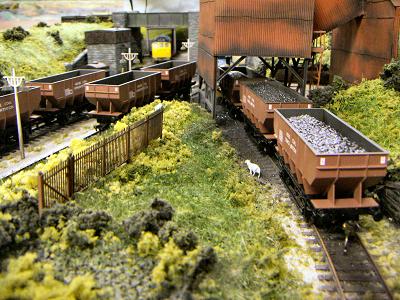 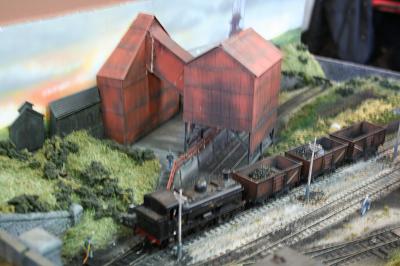 | |
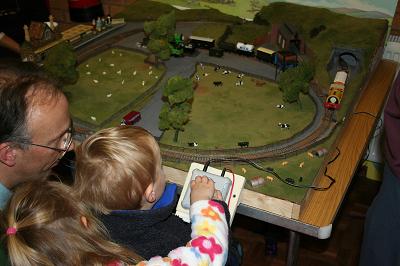 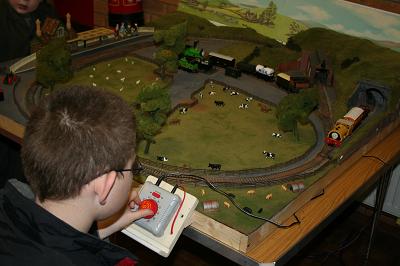 |
We would like to thank Trevor Hallam for looking after the Thomas Layout for many years at our exhibitions and also for refurbishing it at his expense. Unfortunately because of ill health Trevor is no longer able to continue so it was decided to offer Thomas free of charge to Hucclecote Railway Modellers on condition they bring it to all of our future exhibitions. This is the model railway where Children can become Engine Drivers on the Island of Sodor and has of course been inspired by the Reverend Audrey books. Our Thomas and Friends layout has been built for ten years now and in that time we hope it has encouraged many new railway enthusiasts to build a train set of their own. Originally it was intended as a space filler at shows so needed to be small, easy to transport and have a simple track plan, easy for small children to operate. After its first appearance it was clear this model railway would have to be included at all our exhibitions. It incorporates a tunnel, station, level crossing together with locomotive and goods facilities. Train drivers should look out for many of the popular characters; Henry, Percy, Toby, Cranky, the Troublesome Trucks, not forgetting the Sir Topham Hatt better known as the Fat Controller. The famous anthropomorphised rolling stock is mostly from the Thomas range and we are sure most of the adults and all the kids will love it. Happy Driving, but please observe the track speed limits. | |
Westwood Bunker Built in 1903 to supply the expanding army camp, the site played a significant role in both World Wars before being dismantled by the Ministry of Defence in 1991. It was not until the early 2000's before a Society planned to restore the site to its former glory. The Society wanted to demonstrate how the military railways in the United Kingdom were run. The layout is DC operated with a good mixture of locomotives running. The layout features two stations and a yard area, with a mainline connection between exchange siding and the Brookfield (aka the fiddle yard). If you have any questions, feel free to ask and I hope you enjoy. | 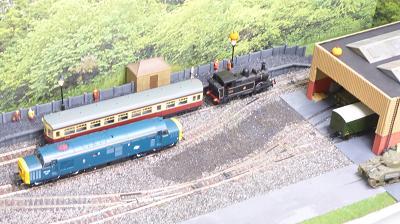 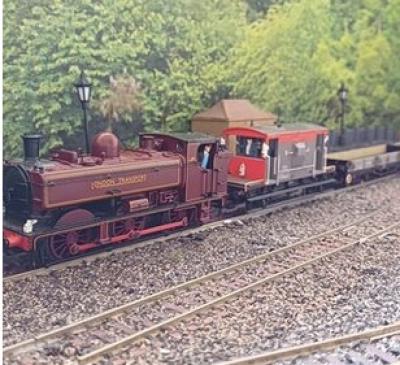 | |
| Displays | ||
Model Bus Federation WEBSITE | NARTM (road transport) WEBSITE | |
Travel 2000 Ltd | Gloucestershire Warwickshire Railway WEBSITE | |
Millbank Down | The Royal Theatre London | |
Saved from scrap | Tumble-down Farm | |
Nash Estates | Civilian aircraft | |
| Modelling Demonstrations | ||
| Mark Begley | Steve Harrod | |
| Trevor Hale | ||
| Trade | ||
| Five Valley Models WEBSITE | Hereford Model Centre WEBSITE | |